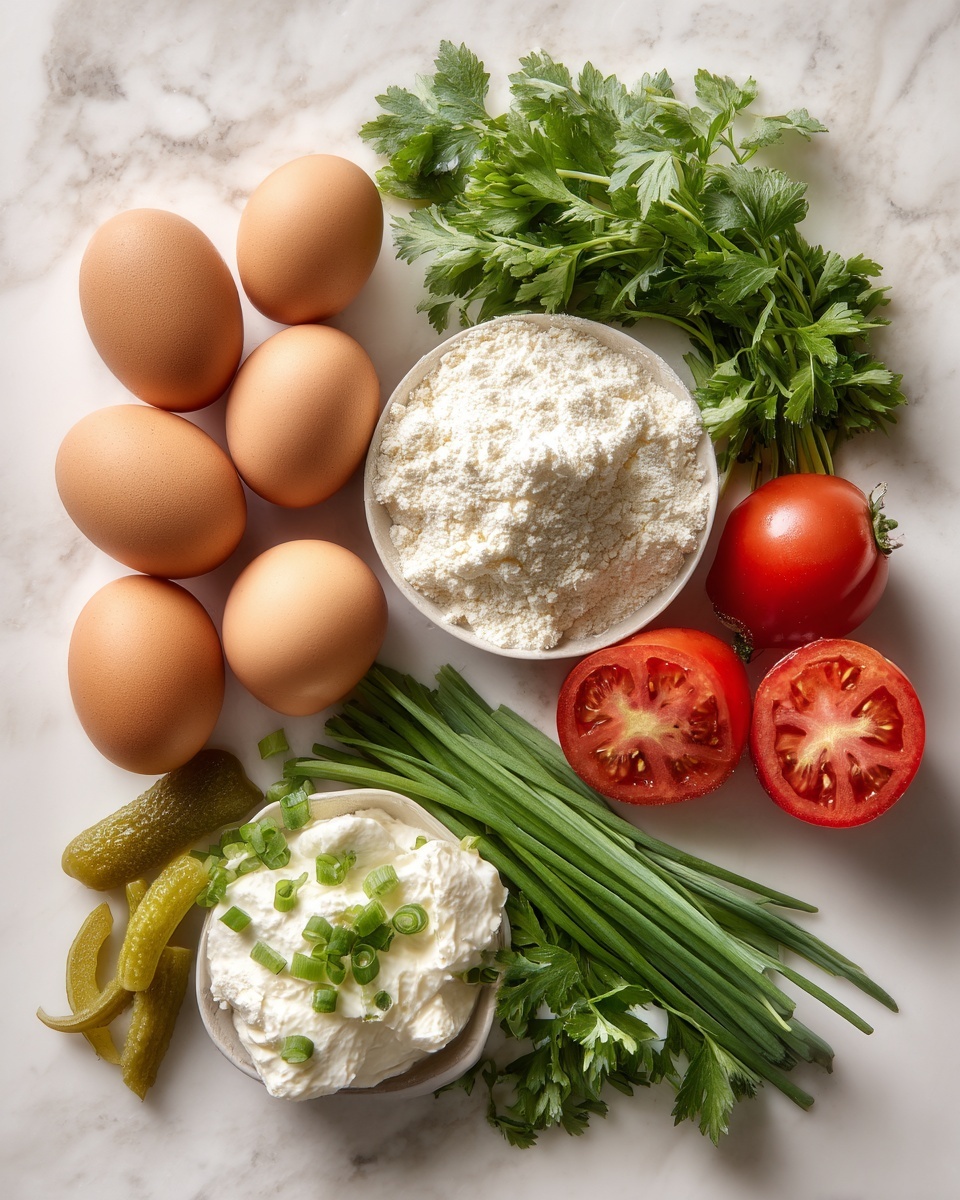There’s something irresistibly fresh and fragrant about this Herby Lebanese Omelet Recipe that just brightens any morning. The mix of herbs and that touch of tangy labneh makes for a light yet satisfying breakfast you’ll want to whip up again and again.
Jump to:
Why You'll Love This Recipe
What I adore about the Herby Lebanese Omelet Recipe is how effortlessly it combines fresh herbs into a fluffy omelet that feels more like a delicate crepe. It’s a simple change from your usual eggs but with a memorable flavor that’s truly special.
- Light and fluffy texture: The addition of flour and baking powder creates an airy, crepe-like omelet that’s different from your everyday scramble.
- Fresh herb punch: Cilantro and green onions add vibrant freshness that wakes up your taste buds.
- Simple, wholesome ingredients: No fancy or hard-to-find items here—just what you likely already have at hand.
- Versatile serving options: Topped with creamy labneh, juicy tomatoes, and pickles, which bring a perfect balance of tang, freshness, and bite.

Ingredients & Why They Work
This omelet’s beauty lies in its simplicity yet harmony of flavors and textures. The eggs provide that classic base; herbs add brightness; flour and baking powder bring a little lift to the batter. Here’s why each ingredient plays its part so perfectly.

- Eggs: They’re the foundation, giving richness and structure to the batter.
- Kosher salt and freshly cracked black pepper: Essential for seasoning, enhancing all the flavors without overpowering.
- Green onion: Adds a mild onion flavor and a bit of crunch for freshness.
- Cilantro: Brings that classic Lebanese herbaceous vibe — bright, citrusy, and unmistakable.
- Flour: Gives the omelet that crepe-like texture by thickening the batter just enough.
- Baking powder: Helps the omelet puff up lightly and remain tender.
- Olive oil: For cooking, adding slight richness and preventing sticking.
- Labneh or Greek yogurt (for topping): Creamy and tangy—it’s the perfect cooling counterpart to the herby omelet.
- Sliced tomato wedges and pickle spears: They add juicy freshness and a salty crunch that elevate each bite.
Make It Your Way
I like to play around with the herbs depending on what’s fresh in my kitchen. Sometimes I swap cilantro for parsley or even add a little mint for a different twist. Feel free to tweak it to your taste—you can’t go wrong with more greens.
- Variation: One weekend, I added a handful of chopped fresh dill—it gave the omelet a wonderful floral note that paired beautifully with the labneh.
- Dietary Choice: For a gluten-free version, you can omit the flour or use chickpea flour instead; the omelet holds together nicely either way.
- Add-ins: You can stir in a little crumbled feta or diced tomatoes into the batter for extra flavor.
- Spice it up: If you like a kick, sprinkle in some Aleppo pepper or red chili flakes.
Step-by-Step: How I Make Herby Lebanese Omelet Recipe
Step 1: Whisk together the flavors
Start by cracking six eggs into a bowl, then season with kosher salt and freshly cracked black pepper. Whisk in finely chopped green onions and cilantro until everything’s evenly combined. This is where the fresh herby aroma starts to fill your kitchen, and trust me, it’ll make you eager to get cooking.
Step 2: Add flour and baking powder for that fluffy texture
Sift the flour and baking powder into your egg mixture. Whisk until smooth—aim for a consistency similar to crepe batter. It should be silky but thick enough to coat the back of your spoon. This little step is what transforms a normal omelet into something uniquely airy and tender.
Step 3: Cook with love and attention
Heat a non-stick sauté pan over medium-high heat and add about half a teaspoon of olive oil. Once the pan is hot, ladle about half a cup of batter in and let it gently set. You’ll know it’s ready to flip when the edges look firm and the bottom is beautifully golden. Flip carefully with a spatula and cook for another minute. Fold in half and transfer to your serving plate. Repeat until all batter is used.
Top Tip
Making the perfect Herby Lebanese Omelet Recipe was a bit of a learning curve for me, especially getting the texture just right. These tips helped me nail it, and I’m sure they’ll save you some trial and error too!
- Don’t overcook: Flip the omelet once the edges are set and the bottom is golden, but keep the heat medium to avoid browning it too dark or drying it out.
- Consistency matters: Getting the batter consistency right makes a huge difference—too thin and it’ll be fragile, too thick and it won’t be tender.
- Use fresh herbs: Dried herbs just don’t cut it here — fresh cilantro and green onion really bring that vibrant flavor.
- Olive oil over butter: The subtle fruitiness of olive oil complements the herbs better and keeps the omelet clean and light.
How to Serve Herby Lebanese Omelet Recipe

Garnishes
I always serve this omelet with a generous spoonful of creamy labneh right on top. It adds a lovely tang and silky texture that makes every bite dreamy. Fresh tomato wedges and a few sprigs of cilantro on the side make it feel bright and wholesome, while pickle spears bring just the right salty crunch to balance the freshness.
Side Dishes
To round out the meal, I often add a simple cucumber and tomato salad tossed with lemon juice and olive oil. Warm pita bread is perfect for scooping up the labneh and omelet. Sometimes I pair it with a small bowl of foul medames (stewed fava beans) for an authentic Lebanese breakfast vibe.
Creative Ways to Present
For brunch with friends, I like arranging the folded omelets on a large platter garnished with pomegranate seeds and a drizzle of za’atar-spiced olive oil. It feels both elegant and comforting. You can even roll the omelet with herbs inside and slice it into pinwheels for a fun appetizer twist.
Make Ahead and Storage
Storing Leftovers
Leftover omelets store well in an airtight container in the fridge for up to two days. I usually layer parchment paper between them to prevent sticking and keep their shape intact.
Freezing
I’ve frozen these omelets wrapped tightly in plastic wrap and placed in a freezer bag. They freeze beautifully and I’ve thawed them overnight in the fridge without losing much texture. It’s a great make-ahead option for busy mornings.
Reheating
To reheat, I prefer a quick warm-up in a non-stick pan over low heat to revive the gentle crispness on the edges. Microwaving works in a pinch but can make them a bit soggy, so keep it short and cover with a paper towel.
Frequently Asked Questions:
Absolutely! Parsley, mint, or dill all work well and bring their own distinct flavors. I encourage experimenting to find what you love best.
Yes! You can omit the flour altogether for a naturally gluten-free and lighter version, or replace it with chickpea flour for a similar texture.
Greek yogurt is the best substitute due to its similar creamy texture and tangy flavor. If you want to mimic labneh’s thicker consistency, strain the yogurt using cheesecloth for a few hours before serving.
Using a good-quality non-stick pan and heating it well before adding the olive oil helps immensely. Also, don’t rush to flip—wait until the edges are set and the bottom has turned golden for an easy release.
Final Thoughts
This Herby Lebanese Omelet Recipe has earned a cozy spot in my breakfast rotation because it’s fresh, flavorful, and feels a little special without being complicated. I’m sure once you try it, you’ll find yourself reaching for those herbs and labneh too. It’s just the kind of recipe that turns an ordinary morning into a mini celebration of flavor—one bite at a time.
Print
Herby Lebanese Omelet Recipe
- Prep Time: 5 minutes
- Cook Time: 7 minutes
- Total Time: 12 minutes
- Yield: 6 servings
- Category: Breakfast
- Method: Frying
- Cuisine: Lebanese
- Diet: Vegetarian
Description
This Herby Lebanese Omelet is a light and flavorful dish featuring eggs mixed with fresh herbs and a touch of flour for texture. Served with creamy labneh or Greek yogurt and fresh tomato wedges, it's a perfect savory breakfast or brunch option inspired by Lebanese cuisine.
Ingredients
Omelet Batter
- 6 eggs
- Kosher salt, to taste
- Freshly cracked black pepper, to taste
- ⅓ cup green onion, finely chopped
- ¼ cup cilantro, finely chopped
- 4 tablespoons flour
- ½ teaspoon baking powder
- 1 tablespoon olive oil
Toppings
- 1 cup Labneh or Greek yogurt
- Sliced tomato wedges
- Fresh cilantro
- Pickle spears
Instructions
- Prepare the batter: In a bowl, whisk together the eggs, kosher salt, freshly cracked black pepper, finely chopped green onion, and cilantro until combined.
- Add dry ingredients: Sift the flour and baking powder into the egg mixture and whisk until smooth. The mixture should be runny but thick enough to coat the back of a spoon, similar to crepe batter.
- Heat the pan: Preheat a non-stick sauté pan over medium-high heat and add ½ teaspoon of olive oil, spreading it evenly.
- Cook the omelet: Ladle about ½ cup of the batter into the pan. Let it cook undisturbed until the bottom is golden and set, then carefully flip the omelet using a spatula. Cook for an additional 1 minute on the other side.
- Fold and serve: Fold the omelet in half and transfer it to a plate. Repeat the cooking process with the remaining batter to make a total of 6 crepes.
- Garnish and enjoy: Serve each omelet with a spoonful of labneh or Greek yogurt, fresh tomato wedges, cilantro, and pickle spears for a delicious and authentic Lebanese breakfast experience.
Notes
- Use a non-stick pan to prevent sticking and make flipping easier.
- Ensure the batter is runny like crepe batter for the best texture.
- Adjust the salt and pepper according to your taste.
- Labneh can be substituted with Greek yogurt for a similar creamy topping.
- For a gluten-free version, substitute the flour with chickpea flour or a gluten-free blend.
- Serve immediately for the best flavor and texture.
Nutrition
- Serving Size: 1 omelet
- Calories: 180 kcal
- Sugar: 1 g
- Sodium: 220 mg
- Fat: 12 g
- Saturated Fat: 2.5 g
- Unsaturated Fat: 8 g
- Trans Fat: 0 g
- Carbohydrates: 8 g
- Fiber: 1 g
- Protein: 10 g
- Cholesterol: 195 mg







Leave a Reply